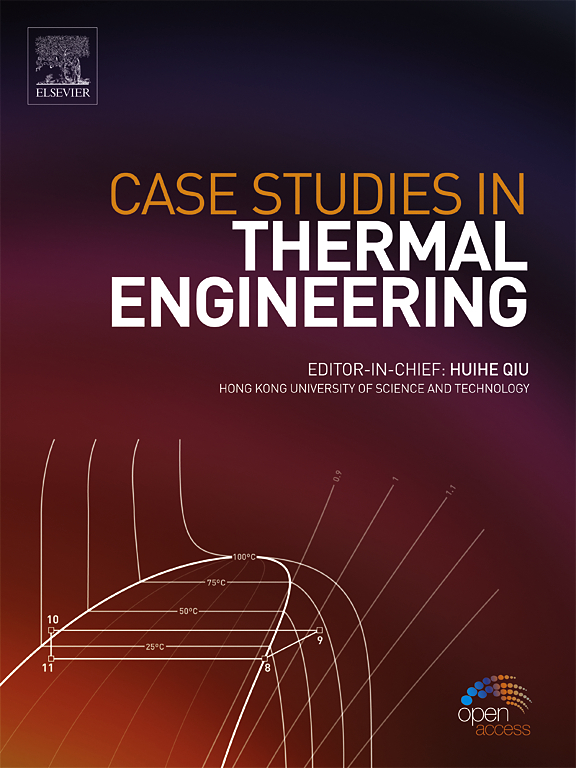基于人工神经网络的电场作用下管束降温预测
IF 6.4
2区 工程技术
Q1 THERMODYNAMICS
引用次数: 0
摘要
本研究旨在探讨人工神经网络(ANN)在预测空气流经低温管库并在电场下运行时的传热行为方面的潜力。到目前为止,还没有研究应用人工神经网络来预测这些特定条件下的传热特性。人工神经网络用于解决热交换器系统的复杂性,因为它有效地处理非线性关系和多个变量,允许准确预测管库中每个柱的空气温度和传热率。本研究使用的管组为直径为15mm的10排管,螺距比为1-4,进气温度为40-45℃,表面温度为30-40℃,风速为0.1-0.25 m/s,高压直流范围为7 - 15kvdc。输出结果为换热率和出风温度。研究评估了最优的神经网络模型结构,包括隐藏层中合适的神经元数量、epoch数量和合适的激活函数,以预测电场下的传热性能。Sigmoid-Purelin激活功能与8个神经元和30个epoch的组合被证明是最适合本研究的。人工神经网络模型在预测管道库中每一行的各种条件下的性能方面表现出了卓越的准确性。最后,在有电场和没有电场的情况下,建立了不同S/D比下温度比与最大雷诺数之间的相关关系。人工神经网络计算的结果与理论传热预测非常吻合,r平方值大于0.99,MSE小于0.000025。此外,当人工神经网络模型在训练数据条件之外进行测试时,与理论传热计算相比,预测结果仍然表现出较高的准确性。本文章由计算机程序翻译,如有差异,请以英文原文为准。
Artificial neural network-based forecasting of air temperature reduction in a tube bank under electric field
This study aims to investigate the potential of Artificial Neural Networks (ANN) in predicting the heat transfer behavior of air as it flows through a tube bank with low temperature and operates under an electric field. To date, no previous studies have applied ANN for predicting heat transfer characteristics under these specific conditions. ANN is employed to address the complexities in heat exchanger systems, as it effectively handles non-linear relationships and multiple variables, allowing for accurate predictions of air temperature and heat transfer rates across each column in the tube bank. The tube bank used in this study consisted of 10 rows of tubes with a diameter of 15 mm, a pitch ratio of 1–4, an inlet air temperature of 40–45 °C, a surface temperature of 30–40 °C, an air velocity of 0.1–0.25 m/s, and high voltage DC ranging from 7 to 15 kVDC. The heat transfer rate and outlet air temperature were the output results. The study evaluated the optimal ANN model structure, including the appropriate number of neurons in the hidden layer, the number of epochs, and the suitable activation function for predicting heat transfer performance under an electric field. The combination of the Sigmoid-Purelin activation function with 8 neurons and 30 epochs proved to be the most suitable for this study. The ANN model demonstrated exceptional accuracy in predicting performance across a variety of conditions for each row in the tube bank. Finally, correlations were developed between the temperature ratio and the maximum Reynolds number at different S/D ratios, both with and without the electric field. The results computed using ANN closely matched theoretical heat transfer predictions, with R-squared values greater than 0.99 and MSE less than 0.000025. Furthermore, when the ANN model was tested beyond the training data conditions, the predicted results still exhibited a high level of accuracy compared to the theoretical heat transfer calculations.
求助全文
通过发布文献求助,成功后即可免费获取论文全文。
去求助
来源期刊

Case Studies in Thermal Engineering
Chemical Engineering-Fluid Flow and Transfer Processes
CiteScore
8.60
自引率
11.80%
发文量
812
审稿时长
76 days
期刊介绍:
Case Studies in Thermal Engineering provides a forum for the rapid publication of short, structured Case Studies in Thermal Engineering and related Short Communications. It provides an essential compendium of case studies for researchers and practitioners in the field of thermal engineering and others who are interested in aspects of thermal engineering cases that could affect other engineering processes. The journal not only publishes new and novel case studies, but also provides a forum for the publication of high quality descriptions of classic thermal engineering problems. The scope of the journal includes case studies of thermal engineering problems in components, devices and systems using existing experimental and numerical techniques in the areas of mechanical, aerospace, chemical, medical, thermal management for electronics, heat exchangers, regeneration, solar thermal energy, thermal storage, building energy conservation, and power generation. Case studies of thermal problems in other areas will also be considered.
 求助内容:
求助内容: 应助结果提醒方式:
应助结果提醒方式:


